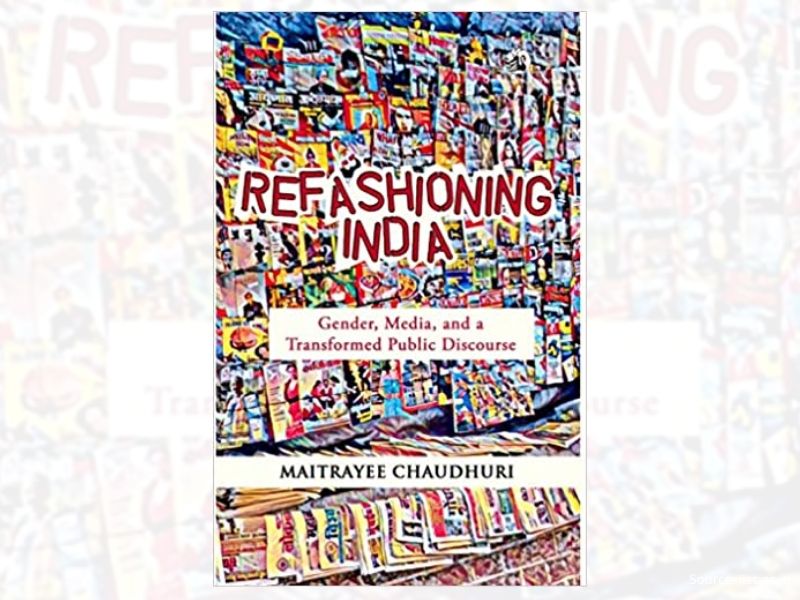Refashioning India: Gender, Media and a transformed public discourse, Maitrayee Chaudhuri, Orient Black Swan; Rs.895; Pages 344
In October 2018, a couple of weeks after the #MeToo Movement hit Indian social media and made its way into mainstream print and broadcast media, a young journalist called this reviewer to ask: ‘How did things come to such a pass in Indian media, where sexual harassment charges against senior editors were an open secret, and where silence meant complicity? Was the Indian media always so compromised?’
In an elliptical manner, some answers to this urgent question can be found in Maitrayee Chaudhuri’s Refashioning India – an exhaustive analysis of the transition of Indian media from its commitment to social responsibility to a market-driven model in neo-liberal India. Reciting the manner in which the media has actively participated in the creation of a changed gendered identity, she links this makeover to the celebration of consumerism and individualism which is spawning a new nationalism.
Chaudhuri’s Refashioning India examines these crucial issues through the lens of gender as she recounts the way public discourse shifted from the ideals of sacrifice and the greater common good, pluralism and diversity in a newly independent nation to the celebration of individualistic aspirations heavily shaped by advertising. The discourse segues into aggressive nationalism with the rise of the BJP and the ideological turn towards Hindutva, aided by a transformed media that is both pliant and actively participant.
In the Introductory chapter written in 1995, Chaudhuri provides a fascinating account of the early critical decades of the nation-building project through the National Planning Committee (NPC) set up in 1938. She analyses the work of the ‘Women’s Role in Planned Economy (WRPE) Sub-Committee’ and traces its terms of reference from, among others, an examination of women in the family, in employment and “social conditions that preclude women from taking her full share in a planned economy”. But even as it acknowledges the role of the woman as a ‘productive worker’, WRPE clearly asserted the importance of private property and accords women the position of repository of culture and tradition.
Post-liberalisation India underwent a marked change and the author devotes a major portion of her analysis to the role played by advertising in catalysing this change. She draws upon numerous instances of advertisements that signal the shift towards unprecedented individual freedom and choice, and the increasing privatisation of the economy as well as of the media.
Advertising that extolls the arrival of the globalised Indian woman and man, the comments of former Times of India CEO, Bhaskar Das, describing readers primarily as targets of advertisers, the near total dependence of the media on advertising revenue — all of these add up to the vast changes in print media and its objectives. This also fed into a new brand of corporatised and market-friendly feminism, most evident in print media of the mid and late 1990s, with its extensive focus on the ‘New Woman’: beauty contests, lifestyle, coverage of celebrities and a near total rejection of feminism as a movement that questioned the prerogatives of patriarchy, gender inequality and deprivation of women.
In Refashioning India, Chaudhuri also examines representations of the family in the media and the transition from the patriarchal joint family to the nuclear family and the media’s fallback on “market common sense” to accommodate tradition with modernity. The shifting sands of public discourse was also reflected in the role played by international institutions and development aid agencies in shaping the agenda on women’s rights, the creation of a transnational sensibility and articulation of a subaltern critique of nationalism.
In an enlightening chapter titled ‘The Indian Media and its Transformed Public’, Chaudhuri examines the ideological role of the media in shaping the dominant public discourse and for “legitimising neo-liberal capitalism in contemporary India”.
The gang rape and death of a physiotherapy student in Delhi in 2012, and the outrage and protests that followed is also examined in detail. Chaudhuri discusses the mediatisation and media convergence that helped set the agenda on the entire issue, the mobilisation of protests and the response of the feminist movement and the state towards amendments to the law.
It would have been useful if the author had examined the new owners of Indian media, the corporate and political leaders who have invested into this business and have a major economic and political stake in the agenda the media has framed. There is also regrettably little mention of self-censorship that operates within the media, the erosion of the rights of media workers and the divide between the media’s star editors and foot soldiers. Perhaps it was this hollowing out of the media’s role as a nation’s conscience keeper that provided fertile ground for the kind of rampant abuse and misogyny that marked the Indian media’s #MeToo movement.
Finally, Chaudhuri highlights how the BJP, which swept General Election 2014, makes use of the language of feminism and women’s equality to aggressively push other agendas (the push to abolish triple talaaq and criminalise Muslim men, and the ruling party’s silent sanction of the ghar wapsi and Love Jihad by sections of the Sangh Parivar as well as the ongoing issue of entry to the Sabarimala Temple). In that sense, the refashioning of the neo-liberal state through gender to assert an aggressive nationalism is complete.
Geeta Seshu (The Book Review, February)
